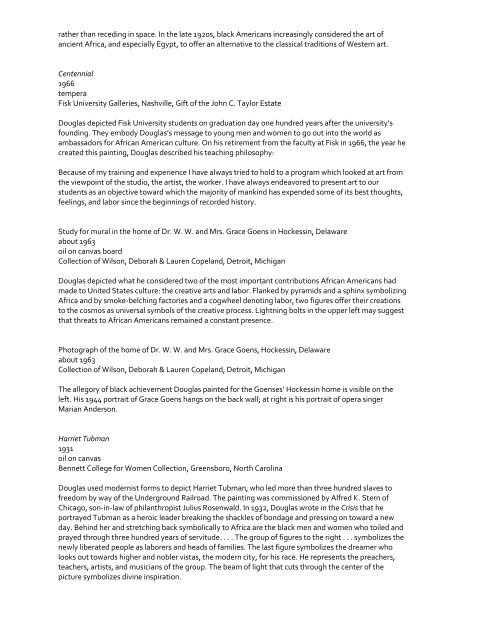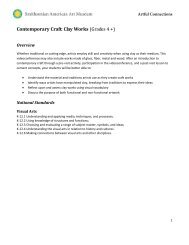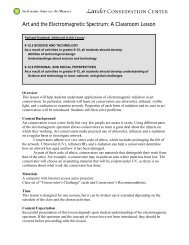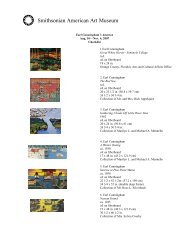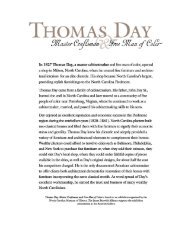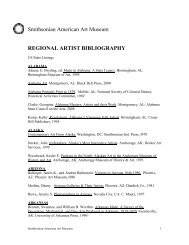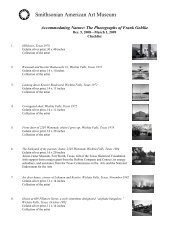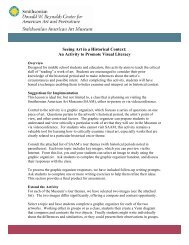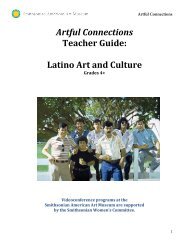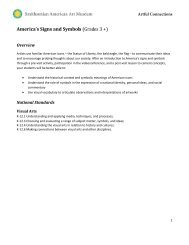Smithsonian American Art Museum Wall Text & Extended Labels
Smithsonian American Art Museum Wall Text & Extended Labels
Smithsonian American Art Museum Wall Text & Extended Labels
You also want an ePaper? Increase the reach of your titles
YUMPU automatically turns print PDFs into web optimized ePapers that Google loves.
ather than receding in space. In the late 1920s, black <strong>American</strong>s increasingly considered the art of<br />
ancient Africa, and especially Egypt, to offer an alternative to the classical traditions of Western art.<br />
Centennial<br />
1966<br />
tempera<br />
Fisk University Galleries, Nashville, Gift of the John C. Taylor Estate<br />
Douglas depicted Fisk University students on graduation day one hundred years after the university’s<br />
founding. They embody Douglas’s message to young men and women to go out into the world as<br />
ambassadors for African <strong>American</strong> culture. On his retirement from the faculty at Fisk in 1966, the year he<br />
created this painting, Douglas described his teaching philosophy:<br />
Because of my training and experience I have always tried to hold to a program which looked at art from<br />
the viewpoint of the studio, the artist, the worker. I have always endeavored to present art to our<br />
students as an objective toward which the majority of mankind has expended some of its best thoughts,<br />
feelings, and labor since the beginnings of recorded history.<br />
Study for mural in the home of Dr. W. W. and Mrs. Grace Goens in Hockessin, Delaware<br />
about 1963<br />
oil on canvas board<br />
Collection of Wilson, Deborah & Lauren Copeland, Detroit, Michigan<br />
Douglas depicted what he considered two of the most important contributions African <strong>American</strong>s had<br />
made to United States culture: the creative arts and labor. Flanked by pyramids and a sphinx symbolizing<br />
Africa and by smoke‐belching factories and a cogwheel denoting labor, two figures offer their creations<br />
to the cosmos as universal symbols of the creative process. Lightning bolts in the upper left may suggest<br />
that threats to African <strong>American</strong>s remained a constant presence.<br />
Photograph of the home of Dr. W. W. and Mrs. Grace Goens, Hockessin, Delaware<br />
about 1963<br />
Collection of Wilson, Deborah & Lauren Copeland, Detroit, Michigan<br />
The allegory of black achievement Douglas painted for the Goenses’ Hockessin home is visible on the<br />
left. His 1944 portrait of Grace Goens hangs on the back wall; at right is his portrait of opera singer<br />
Marian Anderson.<br />
Harriet Tubman<br />
1931<br />
oil on canvas<br />
Bennett College for Women Collection, Greensboro, North Carolina<br />
Douglas used modernist forms to depict Harriet Tubman, who led more than three hundred slaves to<br />
freedom by way of the Underground Railroad. The painting was commissioned by Alfred K. Stern of<br />
Chicago, son‐in‐law of philanthropist Julius Rosenwald. In 1932, Douglas wrote in the Crisis that he<br />
portrayed Tubman as a heroic leader breaking the shackles of bondage and pressing on toward a new<br />
day. Behind her and stretching back symbolically to Africa are the black men and women who toiled and<br />
prayed through three hundred years of servitude. . . . The group of figures to the right . . . symbolizes the<br />
newly liberated people as laborers and heads of families. The last figure symbolizes the dreamer who<br />
looks out towards higher and nobler vistas, the modern city, for his race. He represents the preachers,<br />
teachers, artists, and musicians of the group. The beam of light that cuts through the center of the<br />
picture symbolizes divine inspiration.


